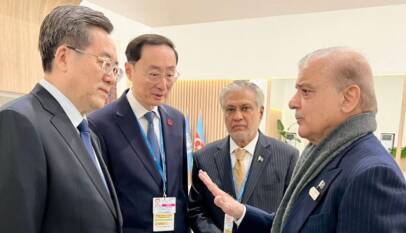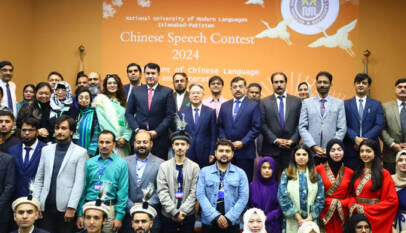CPEC, Pak-China cooperation enhancing despite Indian propaganda
Salis Malik, a freelance journalist writes that India’s slanders against Pakistan are unsubstantiated lies as it continues to spread useless propaganda against the CPEC. Malik also writes that Foreign Office Spokesperson Zahid Hafeez Chaudhri has rejected India’s baseless accusations time again,. Malik said that India also accuses China of carrying out human rights violations in its own country only because it can’t stand the economic cooperation between both Pakistan and China. Salis Malik gave examples of Indian government is using its media to spread fake news CPEC, and maligning Pakistan-China cooperation. The author goes on to write that despite this, CPEC and Pakistan-China cooperation continues to grow.
The Indian tales of libel and slander concerning Pakistan have always gotten off on the wrong foot. For India. Continuously holding Pakistan liable over unsubstantiated claims is a telltale sign of how the Indian media and government have been concocting propaganda against Pakistan. This very propaganda seems to be brewing up a storm again. This time, the eye of the hurricane is focused on the China Pakistan Economic Corridor (CPEC) and China’s cooperation with Pakistan.
Recently, the Indian state minister for external affairs laid a false accusation; claiming that CPEC and BRI were encroaching upon Indian sovereignty as the project ran through the territory of a disputed area on which India claimed its sovereignty. The foreign office spokesperson for Pakistan, Zahid Hafeez, straight out debunked and rejected the claim; explaining that India’s accusations were just a shroud of deceit to divert the public attention from India’s illegal occupation and human rights violations in Indian Occupied Jammu and Kashmir. This can be accentuated by the fact that India wrote misleading letters by using fake platforms to various countries in a bid to falsely accuse China of abusing human rights. Truth is that ever since the start of CPEC, India has not been able to digest Pakistan becoming an economic giant in the future and is trying underhanded tactics to cause hindrance in the BRI project.
Indian propaganda to malign Pakistan has become par for the course of India. The Indian government had never been shy from spreading disinformation against Pakistan and this proved to be true when a study conducted by the EU Disinfo Lab, an information distribution group, provided undeniable evidence that India had been involved in a systematic disinformation campaign against Pakistan, China and CPEC. According to this study, the Indian disinformation campaign, codenamed “Indian Chronicles” created a labyrinth of lies and deceit. This brought back deceased opinions makers and NGOs as a part of India’s fifth-generation hybrid warfare–5GW–against Pakistan. Under this campaign, more than 700 news outlets were resurrected and various “zombie” NGOs were set up to allow the repackaging and distortion of information. Fallacies in global search engines were targeted by the manipulation of over 500 website domains. The main intent of this project was to underpin and enhance anti-Pakistan and anti-China sentiments and help promote a positive image of India on the global stage by damaging the reputation of countries not in line with “Indian Ideology.” One such NGO, dubbed as “environment” falsely accused how Indian rivers were being diverted for hydropower projects under the CPEC. The NGO misinformed that how the CPEC project was damaging the Indian ecology by diverting all the water and causing a shortage.
The Indian media has also used a plethora of other propaganda by utilising muckraking and yellow journalism as well. There has been a mushrooming of rumours laid out by their journalists, claiming that the appearance of China in Gwadar has actually reiterated the Baloch insurgency. The Indian media is swift to make false claims about how Gwadar seems to be not safe for investing in foreign business but that’s where the Indian media is twisting the facts. Yes, in the past, there have been attacks in the Baloch region but has the Indian media ever wondered who the ring leader is behind all of this? Why doesn’t the Indian media reveal or report the connection between Mama Qadeer and India? Why is the Indian media always silent about Kulbhushan Yadhav, the Indian infiltrator and spy, who himself took responsibility for pulling the strings in a surfeit of terrorist activities in the country, especially in Balochistan, Karachi and against CPEC? This is what the Indian media will not tell. They will not reveal how Kulbhushan Yadav was aiding Baloch separatists at RAW’s decree, in a bid to derail advancements in the CPEC project but they will blatantly lie that the ensuing violence in Balochistan is due to the presence of a foreign investor.
The Indian media hasn’t been shy about starting new campaigns against CPEC at the behest of many foreign powers. One such campaign was the “Chinese Debt Trap” that assumes Chinese investments as being synonymous with burying Pakistan under debt. However, if we examine and analyse previous data about the global debt patterns, we will realise that debt traps often occur when countries accumulate consumptive loans, which are mostly non-productive. The CPEC, on the other hand, is very different in that regard as it has created more than 80,000 jobs and will continue to create a plethora of more jobs once this project completes. Moreover, the CPEC provides an opportunity for several countries to benefit from this trade route namely Central Asian and South Asian countries. This will boost the Pakistani economy to a great extent. Another important aspect that debunks the ‘debt trap’ propaganda is the overall percentage the CPEC investment constitutes. With being just 5.6 per cent of the Pakistani debt, the farcical Indian claims of CPEC being a debt trap is a far cry from what it actually is. The Indian media has often tried to compare this investment with the Chinese investments made in Sri Lanka and Sudan, but the political and economic situation, when compared to Pakistan, is like comparing apples to oranges. The debt trap prevalent in those countries is actually the result of borrowing money from Western powers. More importantly, the eventual change in the US interest rates had buried Sri Lanka and Sudan under severe debts.
Chinese Ambassador highlights significance of Third Plenary Session for China-Pakistan cooperation
The Third Plenary Session of the 20th Central Committee of the Communist Party of China ha…











